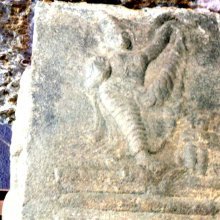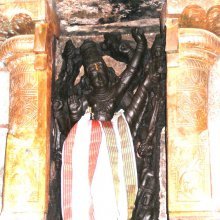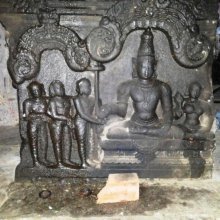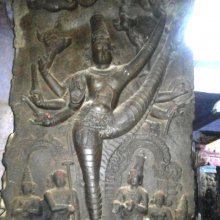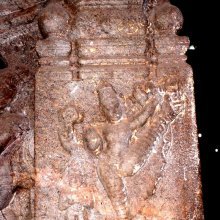Mahabali, Mahābalī: 10 definitions
Introduction:
Mahabali means something in Buddhism, Pali, Hinduism, Sanskrit, Marathi. If you want to know the exact meaning, history, etymology or English translation of this term then check out the descriptions on this page. Add your comment or reference to a book if you want to contribute to this summary article.
Images (photo gallery)
In Hinduism
Purana and Itihasa (epic history)
Source: archive.org: Puranic EncyclopediaMahābali (महाबलि).—See under the word Bali.
Source: archive.org: Shiva Purana - English TranslationMahābali (महाबलि) is the name of a deity who fought on Vīrabhadra’s side in his campaign to destroy Dakṣa’s sacrifice, according to the Śivapurāṇa 2.2.37. Accordingly:—“[...] Vīrabhadra took up all the great miraculous weapons for his fight with Viṣṇu and roared like a lion. [...] A noisy terrible fight ensued between the Gaṇas and the guardians of the quarters, both roaring like lions. [...] O sage, a terrible fight provoking horripilation took place between Mahābali and Varuṇa with various weapons”.

The Purana (पुराण, purāṇas) refers to Sanskrit literature preserving ancient India’s vast cultural history, including historical legends, religious ceremonies, various arts and sciences. The eighteen mahapuranas total over 400,000 shlokas (metrical couplets) and date to at least several centuries BCE.
General definition (in Hinduism)
Source: Wisdom Library: HinduismMahabali (or Bali) was a benevolent Asura King defeated by the god Vishnu.
See Bali.
In Buddhism
Tibetan Buddhism (Vajrayana or tantric Buddhism)
Source: Wisdom Library: Tibetan Buddhist Teachers, Deities and other Spiritual beingsMahābalī (महाबली) refers to one of the “Fifty-eight Wrathful Deities” (Tibetan: khro bo lha nga brgyad) according to various sources such as the Guhyagarbha Tantra and the Tibetan Book of the Dead.—They feature in Tantric teachings and practices which focus on purifying elements of the body and mind. These deities [e.g., Mahābalī] form part part of the the Hundred Peaceful and Wrathful Deities who manifest to a deceased person following the dissolution of the body and consciousness whilst they are in the intermediate state (bardo) between death and rebirth. Mahābalī is part of the “six yoginis corresponding to the activity of magnetizing” and is also known as Mahābalā. She is known in Tibetan as stobs chen khyung gdong.
Source: academia.edu: The Structure and Meanings of the Heruka MaṇḍalaMahābalī (महाबली) or Mahābala is the name of a Ḍākinī who, together with the Vīra (hero) named Mahābalā forms one of the 36 pairs situated in the Hṛdayacakra, according to the 10th century Ḍākārṇava chapter 15. Accordingly, the hṛdayacakra refers to one of the four divisions of the sahaja-puṭa (‘innate layer’), situated within the padma (lotus) in the middle of the Herukamaṇḍala. The 36 pairs of Ḍākinīs [viz., Mahābalī] and Vīras are reddish yellow in color; they each have one face and four arms; they hold a skull bowl, a skull staff, a small drum, and a knife.

Tibetan Buddhism includes schools such as Nyingma, Kadampa, Kagyu and Gelug. Their primary canon of literature is divided in two broad categories: The Kangyur, which consists of Buddha’s words, and the Tengyur, which includes commentaries from various sources. Esotericism and tantra techniques (vajrayāna) are collected indepently.
Mahayana (major branch of Buddhism)
Source: De Gruyter: A Buddhist Ritual Manual on AgricultureMahābali (महाबलि) refers to a “great offering (of barley-meal)” (suitable for an offering ritual), according to the Vajratuṇḍasamayakalparāja, an ancient Buddhist ritual manual on agriculture from the 5th-century (or earlier), containing various instructions for the Sangha to provide agriculture-related services to laypeople including rain-making, weather control and crop protection.—Accordingly, [As the Bhagavān said]: “Now I shall teach the offering manual which is auspicious and can bring about any effect. [...] Seven coiling figures should be made and rice spirals. Twenty-one figures should be prepared one after the other. Boiled rice, milk rice, a dish of rice and peas, yoghurt and thickened milk should be placed. Fruits and flowers should be placed. Four jars should be placed. Preceded by a great offering (mahābali) barley-meal should be placed as foremost. [...]”.

Mahayana (महायान, mahāyāna) is a major branch of Buddhism focusing on the path of a Bodhisattva (spiritual aspirants/ enlightened beings). Extant literature is vast and primarely composed in the Sanskrit language. There are many sūtras of which some of the earliest are the various Prajñāpāramitā sūtras.
Languages of India and abroad
Marathi-English dictionary
Source: DDSA: The Molesworth Marathi and English Dictionarymahābali (महाबलि).—m (S) pop. mahābaḷī m A great offering (as of dressed food, of flesh &c.) in contradistinction from the ordinary offerings, or as made to propitiate the Pishach &c.
--- OR ---
mahābaḷī (महाबळी).—a Very powerful or strong.
Source: DDSA: The Aryabhusan school dictionary, Marathi-Englishmahābaḷī (महाबळी).—m Great offering. a Very power- ful.
Marathi is an Indo-European language having over 70 million native speakers people in (predominantly) Maharashtra India. Marathi, like many other Indo-Aryan languages, evolved from early forms of Prakrit, which itself is a subset of Sanskrit, one of the most ancient languages of the world.
Sanskrit dictionary
Source: Cologne Digital Sanskrit Dictionaries: Monier-Williams Sanskrit-English DictionaryMahābali (महाबलि):—[=mahā-bali] [from mahā > mah] m. Name of the giant Bali, [Monier-Williams’ Sanskrit-English Dictionary]
Sanskrit, also spelled संस्कृतम् (saṃskṛtam), is an ancient language of India commonly seen as the grandmother of the Indo-European language family (even English!). Closely allied with Prakrit and Pali, Sanskrit is more exhaustive in both grammar and terms and has the most extensive collection of literature in the world, greatly surpassing its sister-languages Greek and Latin.
Nepali dictionary
Source: unoes: Nepali-English DictionaryMahābalī (महाबली):—adj. very strong; powerful; mighty; stalwart;
Nepali is the primary language of the Nepalese people counting almost 20 million native speakers. The country of Nepal is situated in the Himalaya mountain range to the north of India.
See also (Relevant definitions)
Partial matches: Maha, Mahanta, Bali.
Starts with: Mahabali Buti, Mahabalipura, Mahabalipurakshetra.
Query error!
Full-text (+18): Mahabali Buti, Bali, Mahabalipura, Mavali, Mapali, Makapali, Vajrajvala, Vindhyavali, Vayirocanan, Virocanasuta, Pakharada, Fifty-eight wrathful deities, Mavalivanan, Tripadabhumi, Vairocanan, Palicakkaravartti, Makavali-vanaracan, stobs chen khyung gdong, Siddhashrama, Mrigankaka.
Relevant text
Search found 27 books and stories containing Mahabali, Maha-bali, Mahā-bali, Mahā-balī, Mahābali, Mahābaḷī, Mahābalī, Mahanta-bali; (plurals include: Mahabalis, balis, balīs, Mahābalis, Mahābaḷīs, Mahābalīs). You can also click to the full overview containing English textual excerpts. Below are direct links for the most relevant articles:
Puranic encyclopaedia (by Vettam Mani)
Garga Samhita (English) (by Danavir Goswami)
Verse 6.3.15 < [Chapter 3 - Lord Balarāma’s Wedding]
Chaitanya Bhagavata (by Bhumipati Dāsa)
Verse 2.13.342 < [Chapter 13 - The Deliverance of Jagāi and Mādhāi]
Verse 2.15.25 < [Chapter 15 - Descriptions of Mādhavānanda’s Realization]
Verse 3.1.230 < [Chapter 1 - Meeting Again at the House of Śrī Advaita Ācārya]
Tiruvaymoli (Thiruvaimozhi): English translation (by S. Satyamurthi Ayyangar)
Pasuram 9.5.5 < [Section 5 - Fifth Tiruvaymoli (Innuyirc cevalum)]
Pasuram 3.8.9 < [Section 8 - Eighth Tiruvaymoli (Mutiyane)]
Pasuram 8.2.9 < [Section 2 - Second Tiruvaymoli (Nankal varivalai)]
Later Chola Temples (by S. R. Balasubrahmanyam)
Temples in Gudimallam < [Chapter IV - Temples of Vikrama Chola’s Time]
The history of Andhra country (1000 AD - 1500 AD) (by Yashoda Devi)
Part 2 - Aggaparaju (A.D. 1023) < [Chapter XVI - The Banas]
Introduction (Bana dynasty) < [Chapter XVI - The Banas]
